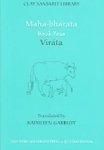
Book Summary
"The books line up on my shelf like bright Bodhisattvas ready to take tough questions or keep quiet company. They stake out a vast territory, with works from two millennia in multiple genres: aphorism, lyric, epic, theater, and romance." --Willis G. Regier, "The Chronicle Review" "No effort has been spared to make these little volumes as attractive as possible to readers: the paper is of high quality, the typesetting immaculate. The founders of the series are John and Jennifer Clay, and Sanskritists can only thank them for an initiative intended to make the classics of an ancient Indian language accessible to a modern international audience." --"The Times Higher Education Supplement" "The Clay Sanskrit Library represents one of the most admirable publishing projects now afoot. . . . Anyone who loves the look and feel and heft of books will delight in these elegant little volumes." --"New Criterion" "Published in the geek-chic format." --"BookForum" "Very few collections of Sanskrit deep enough for research are housed anywhere in North America. Now, twenty-five hundred years after the death of Shakyamuni Buddha, the ambitious Clay Sanskrit Library may remedy this state of affairs." --"Tricycle" aNow an ambitious new publishing project, the Clay Sanskrit Library brings together leading Sanskrit translators and scholars of Indology from around the world to celebrate in translating the beauty and range of classical Sanskrit literature. . . . Published as smart green hardbacks that are small enough to fit into a jeans pocket, the volumes are meant to satisfy both the scholar and the lay reader. Each volume has a transliteration of the original Sanskrit texton the left-hand page and an English translation on the right, as also a helpful introduction and notes. Alongside definitive translations of the great Indian epics -- 30 or so volumes will be devoted to the Maha-bharat itself -- Clay Sanskrit Library makes available to the English-speaking reader many other delights: The earthy verse of Bhartri-hari, the pungent satire of Jayanta Bhatta and the roving narratives of Dandin, among others. All these writers belong properly not just to Indian literature, but to world literature.a --"LiveMint" aThe Clay Sanskrit Library has recently set out to change the scene by making available well-translated dual-language (English and Sanskrit) editions of popular Sanskritic texts for the public.a --"Namarupa" "The Book of Virata" details the Pandavas' 13th year in exile, when they live disguised in King Virata's court. They suffer the humiliation of becoming servants; a topic explored both through comedy and pathos. Having maintained their disguise until the very end of the year, then their troubles really begin. Bhima is forced to come to Draupadi's rescue when King Virata's general, Kichaka, sets his sights on her. Duryodhana and the Tri-gartas decide to invade the defeated Virata's kingdom, unaware the Pandavas are hidden there. In the ensuing battles the Pandavas play a crucial role, save Virata and reveal their true identities. The book ends in celebration, with the Pandavas ready to return from exile and reclaim their kingdom. However, the battles in "Virata" foreshadow the war to come, proving it will not be easy. Co-published by New York University Press and the JJC Foundation For more on this title and other titles in the ClaySanskrit series, please visit http: //www.claysanskritlibrary.org
Book Details
| Book Name | Mahabharata Book Four: Vir Ta |
| Author | Kathleen Garbutt |
| Publisher | New York University Press (Feb 2007) |
| ISBN | 9780814731833 |
| Pages | 400 |
| Language | English |
| Price | 946 |








